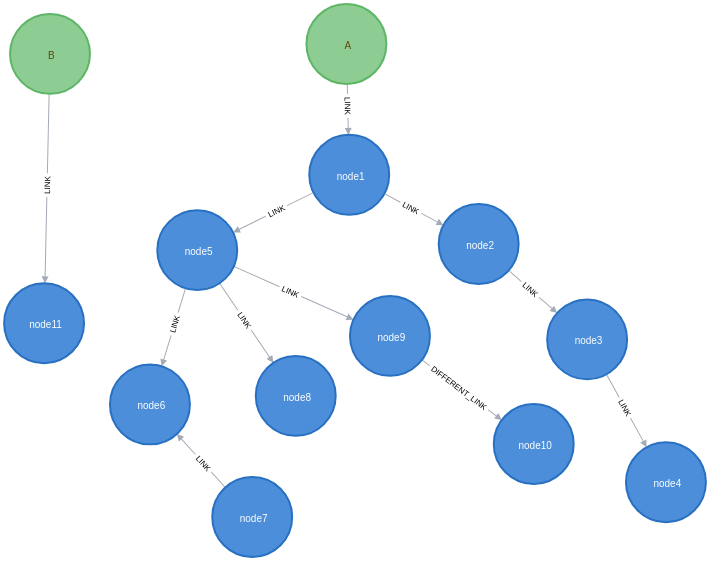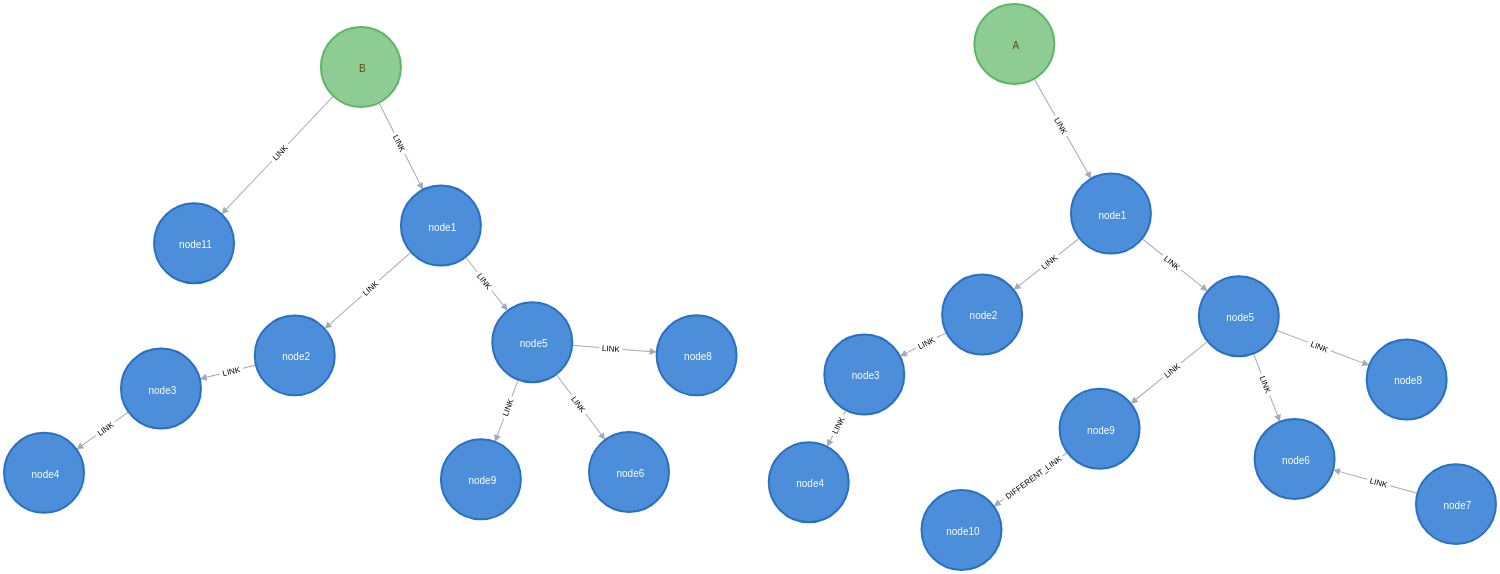Clone subgraph
The APOC library contains procedures that can be used to clone subgraphs. These procedures can be used to clone a subgraph defined either by a list of nodes and a list of relationships, or a list of paths. This is useful when you want to ensure the cloned subgraph is not connected to the original nodes, or to nodes outside the subgraph.
If relationships are not provided, all relationships between the given nodes will be cloned.
In the config map, a list of standinNodes (of pairs of nodes) can be provided, allowing an existing node in the graph to act as a standin for another node in the cloned subgraph.
This can be useful for attaching the cloned subgraph to another node in the graph (rather than cloning a node).
Procedures for cloning subgraphs
| Qualified Name | Type |
|---|---|
|
Procedure |
|
Procedure |
Examples
The examples below will further explain these procedures.
CREATE (rootA:Root{name:'A'}),
(rootB:Root{name:'B'}),
(n1:Node{name:'node1', id:1}),
(n2:Node{name:'node2', id:2}),
(n3:Node{name:'node3', id:3}),
(n4:Node{name:'node4', id:4}),
(n5:Node{name:'node5', id:5}),
(n6:Node{name:'node6', id:6}),
(n7:Node{name:'node7', id:7}),
(n8:Node{name:'node8', id:8}),
(n9:Node{name:'node9', id:9}),
(n10:Node{name:'node10', id:10}),
(n11:Node{name:'node11', id:11}),
(n12:Node{name:'node12', id:12})
CREATE (rootA)-[:LINK]->(n1)-[:LINK]->(n2)-[:LINK]->(n3)-[:LINK]->(n4)
CREATE (n1)-[:LINK]->(n5)-[:LINK]->(n6)<-[:LINK]-(n7)
CREATE (n5)-[:LINK]->(n8)
CREATE (n5)-[:LINK]->(n9)-[:DIFFERENT_LINK]->(n10)
CREATE (rootB)-[:LINK]->(n11)
:LINK relationships, and attaches that subgraph to rootB. rootB acts as a standin for rootA, which is not cloned:MATCH (rootA:Root{name:'A'}),
(rootB:Root{name:'B'})
MATCH path = (rootA)-[:LINK*]->(node)
WITH rootA, rootB, collect(path) as paths
CALL apoc.refactor.cloneSubgraphFromPaths(paths, {
standinNodes:[[rootA, rootB]]
})
YIELD input, output, error
RETURN input, output, errorIf the above query is run, it will result in the following graph:

Another approach is to use apoc.refactor.cloneSubgraph(), providing the lists of nodes and relationships which form the subgraph.
The nodes and relationships from the yielded output can be obtained using apoc.path.subgraphAll(), filtering to the relationship types in the call to that procedure.
CREATE (rootA:Root2{name:'A'}),
(rootB:Root2{name:'B'}),
(n1:Node2{name:'node1', id:1}),
(n2:Node2{name:'node2', id:2}),
(n3:Node2{name:'node3', id:3}),
(n4:Node2{name:'node4', id:4}),
(n5:Node2{name:'node5', id:5}),
(n6:Node2{name:'node6', id:6}),
(n7:Node2{name:'node7', id:7}),
(n8:Node2{name:'node8', id:8}),
(n9:Node2{name:'node9', id:9}),
(n10:Node2{name:'node10', id:10}),
(n11:Node2{name:'node11', id:11}),
(n12:Node2{name:'node12', id:12})
CREATE (rootA)-[:LINK]->(n1)-[:LINK]->(n2)-[:LINK]->(n3)-[:LINK]->(n4)
CREATE (n1)-[:LINK]->(n5)-[:LINK]->(n6)<-[:LINK]-(n7)
CREATE (n5)-[:LINK]->(n8)
CREATE (n5)-[:LINK]->(n9)-[:DIFFERENT_LINK]->(n10)
CREATE (rootB)-[:LINK]->(n11):LINK relationships, and attaches that subgraph to rootB. rootB acts as a standin for rootA, which is not cloned:MATCH (rootA:Root2{name:'A'}),
(rootB:Root2{name:'B'})
CALL apoc.path.subgraphAll(rootA, {relationshipFilter:'LINK>'})
YIELD nodes, relationships
CALL apoc.refactor.cloneSubgraph(
nodes,
[rel in relationships WHERE type(rel) = 'LINK'],
{ standinNodes:[[rootA, rootB]] })
YIELD input, output, error
RETURN input, output, errorThe resulting graph will be the same as that returned in the previous example, where apoc.refactor.cloneSubgraphFromPaths() was called.